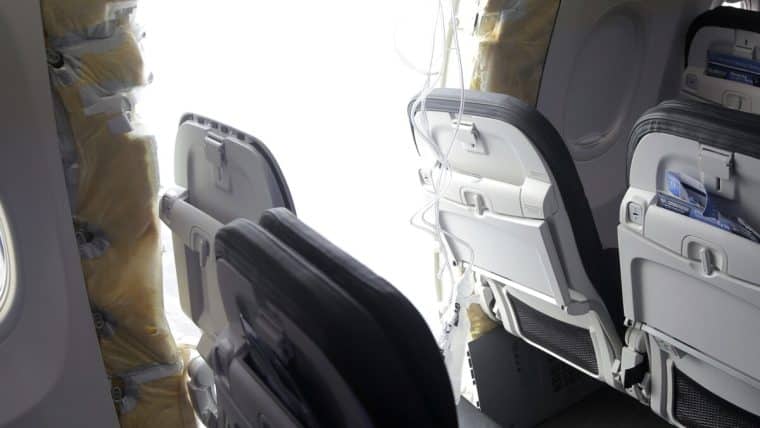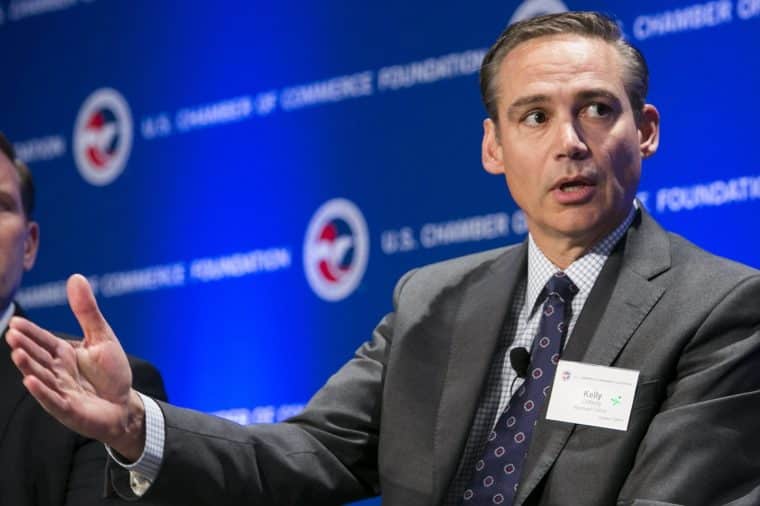The US National Transportation Safety Board (NTSB) opened a two-day hearing this week to investigate the alarming in-flight incident involving an Alaska Airlines Boeing 737 MAX on January 5, 2024.
During the proceeding, some shocking testimonies from Boeing factory workers revealed countless ongoing safety concerns at the aircraft manufacturer’s production facilities at a point when the company is trying to recover from the fallout of the 737 MAX crashes that took place in 2018 and 2019.
A Poorly Installed Door Plug Causes a Mid-Flight Incident

The incident occurred shortly after the plane took off from Portland, Oregon and as Alaska Airlines Flight 1282 was reaching an altitude of 16,000 feet.
Suddenly, a large section of the aircraft’s fuselage, known as the “door plug” was violently ripped off the structure and caused a rapid decompression. Dramatic video footage showed oxygen masks deploying and objects being sucked out of the hole that the plug left at the plane’s side.
Miraculously, none of the 176 passengers and 6 crew members on board suffered major injuries. However, if the plane was at a higher altitude or if there were passengers seated directly next to the faulty panel, there would have likely been casualties. Meanwhile, the pilots were able to make an emergency landing back at Portland International Airport within 30 minutes of the event.
The NTSB’s preliminary investigation found that four bolts that should have secured the door plug were missing, allowing the panel to become detached in the middle of the flight. Investigators determined that the bolts had been removed during a repair at Boeing’s Washington-based factory before the aircraft’s delivery to Alaska Airlines in October 2023. Surprisingly, they were never reinstalled.
Elizabeth Lund, Boeing’s senior vice president for quality, acknowledged in June that the company’s own internal processes failed and, as a result, the plane was allowed to leave the factory without these critical pieces being adequately added. “We believe that plug was opened without the correct paperwork,” Lund told reporters at the time.
“There was a non-compliance to our processes at that point,” she affirmed.
However, the NTSB was not pleased with Lund’s public comments, which the safety board said contained “inaccurate or unknown” speculation about the incident that the agency was not aware of. These remarks should have not been made public either as they concerned an ongoing investigation.
As a result, the NTSB sanctioned Boeing, barring the company from reviewing investigative materials or questioning other witnesses at this week’s hearing.
Boeing’s Corporate Culture is Deemed “Garbage” by One Employee
The testimony from current and former Boeing employees painted a troubling picture of the company’s manufacturing operations and safety culture. Workers described a relentless drive to keep pushing the aircraft forward within the assembly line, even at the expense of following proper procedures and quality controls.
One Seattle-area employee on a crew that specializes in removing and reinstalling door plugs told investigators that Boeing’s safety culture was “garbage. Nobody’s accountable.” He emphasized that workers face constant pressure to “push-push-push” and complete tasks quickly, rather than allowing them to take the time to do them correctly.
Also read: Boeing Net Worth: Aerospace Giant’s Market Cap and Revenue
This employee also claimed that he had been reassigned to an area he described as a literal “jail” after raising concerns during the NTSB investigation. Elizabeth Lund acknowledged the transfer but denied that it was punitive. She claimed that this worker maintained the same pay, shift, and benefits.
Meanwhile, Lloyd Catlin, an official representing Boeing’s machinists union, corroborated the worker’s account, saying that such transfers are a clear “punitive message” that aims to discourage employees from reporting safety issues. This employee was also far from the only one to claim that Boeing punished whistleblowers for speaking out.
Workers Are Not Properly Trained to Perform Critical Tasks Nowadays at Boeing
Several witnesses testified that Boeing’s workforce has become significantly less experienced in recent years. The COVID-19 pandemic seems to have exacerbated this problem.
Lund highlighted that employees previously came from military backgrounds and had experience in the aerospace field. However, the health crisis forced the company to hire more people to speed up their manufacturing processes and this resulted in lower-skilled new hires being added to the payroll.
Another Boeing official emphasized that nearly all workers previously had some sort of experience working with sheet metal. However, only 5% currently possess that kind of knowledge, and Boeing has been obligated to train new hires in basic tasks like drilling holes and installing fasteners.
It was also mentioned that workers who were involved in the installation of the door plug that blew up in the Alaska Airlines incident were not adequately trained to perform that task and the person who was supposed to oversee the work did not “really understand doors”.
Getting Boeing to Adopt Safety Improvements Has Been an “Uphill” Battle
The hearing also shed a light on the ongoing struggles between Boeing and aviation regulators, particularly the Federal Aviation Administration (FAA). Former FAA official Jim Phoenix testified that it has been an uphill battle to push Boeing to implement meaningful safety improvements.
“You need a lot of leverage to get Boeing to change and then when Boeing changes, it’s very slow and it took a long time for them to really understand that their quality system needed to improve,” Phoenix said.
Also read: Boeing Net Worth: Aerospace Giant’s Market Cap and Revenue
NTSB chair Jennifer Homendy echoed these sentiments, openly questioning the state of Boeing’s relationship with its own employees. “A healthy management-employee relationship is based on trust, treatment and transparency,” Homendy said. “I don’t see these here.”
Boeing Faces Multiple Investigations While Its Finances Keep Suffering

The door plug blowout incident has triggered a cascade of additional scrutiny and legal troubles for Boeing. The FBI informed passengers on Flight 1282 that they may be considered victims of a crime, suggesting that criminal charges could be filed against those in charge of overseeing the plane’s manufacturing process and even the company itself.
Meanwhile, the Justice Department had already secured a guilty plea from Boeing for conspiring to defraud regulators in connection with the deadly 737 MAX crashes of 2018 and 2019. Prosecutors are now pursuing further action against the company.
In addition to the NTSB’s ongoing investigation, Boeing is also facing multiple other probes from the FAA, Congress, and the company’s own internal safety review board. The incidents have only added to Boeing’s mounting financial woes. Since 2019, the company has lost approximately $25 billion.
On July 31, Boeing appointed a new President and Chief Executive Officer named Kelly Ortberg to try to appease regulators and communicate that they are making meaningful changes to its practices.
As the investigations continue, Boeing is scrambling to address the root causes of its manufacturing issues. The company is working on design changes to its door plugs that would include sensors. These should supposedly alert crew members if the panels are not properly secured. Boeing is also ramping up its training efforts for factory workers and attempting to improve its overall safety culture.
However, these recent testimonies have revealed the extent of the issues that the company faces to ensure adequate safety controls including inexperienced workers, resistance to regulatory oversight, and a “quantity over quality” culture.
The door plug incident may ultimately be a defining moment that forces the company to rethink its approach to regain some of the credibility it has lost over these past few years.